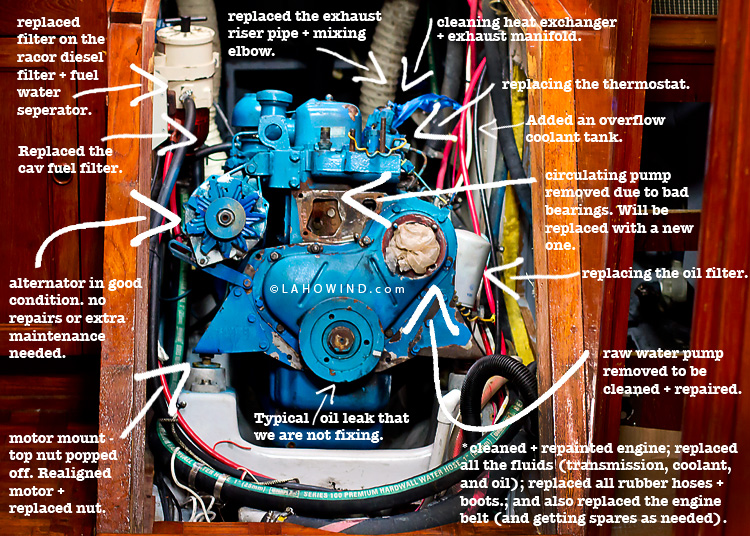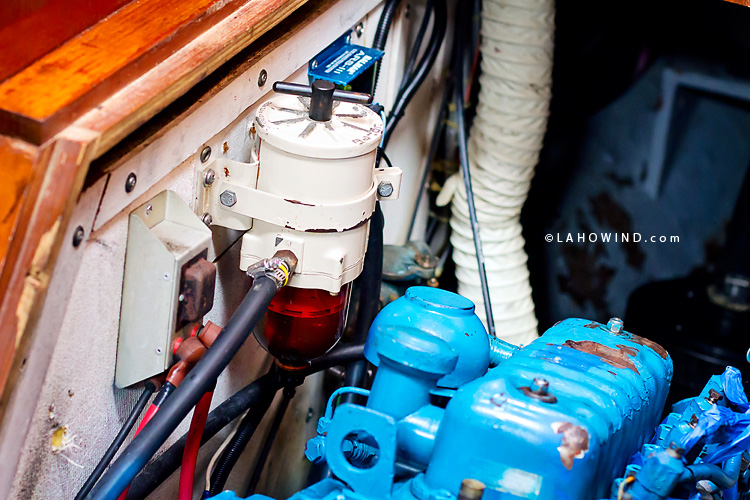Let’s face it, when you think sailing, you don’t immediately ponder up beautiful images of…diesel engines. Or do you?
Forget the glitz and glam of breezy sails, wind in your hair, and sunshine on your face. Boat ownership also entails a fair amount of dirty work. And maintaining the engine is one of those less-than-fun jobs.
I’m fairly certain that any owner of a diesel-powered boat, sail or power, should learn the fundamentals of engine operation and maintenance. And if you’re cruising to uncharted territory (i.e. foreign countries where spare parts and cheap labor aren’t always in full supply), then gosh you really should learn the ropes.
Jereme had already spent a fair amount of time getting to know where various parts were on our engine and cleaning miscellaneous pieces, like the bilge. But neither of us really have a clue when it comes to regular engine maintenance on our 50-HP Perkins 4-108 diesel.
So, we’ve hired a diesel mechanic to do a little overhauling on our good ‘ole Perkins AND teach us mostly Jereme how to do the regular maintenance going forward. Our diesel mechanic, John Cox of Cox’s Mobile Marine, came so highly recommended. Clearly, he’s “the guy” you want working on your engine (here in Naples, Florida).
Here’s the low down of our engine overhaul and tune-up…

Thermostat. There wasn’t one. So we’re replacing it. Simple enough. Most likely when the previous owner had the boat, the thermostat either broke and wasn’t ever replaced, or there may have been an overheating issue and the thermostat was removed to resolve that issue. Who knows? We don’t totally know for sure. But in any case, we are installing a new one for good measure.
New Overflow Coolant Tank. Like cars, when the coolant heats up, it expands. Previously, our coolant just came out of the cap and drained into the bilge. The better solution is to add an overflow hose and tank so that it flows into the tank and not the bilge. Hence, our new coolant tank. 
Circulating Pump. This is the pump that circulates coolant in the engine. Our old pump was loose and wobbly so we needed a full replacement. Repairing or fixing the old one is not cost effective at all, so we opted for a brand new pump.
Oil Filter. Pretty standard boat/engine maintenance. And needs to be done every 100 hours. We weren’t sure when the last time this was done, so we’re, of course, doing it now.
Raw Water Pump. The pump that brings in salt water to remove heat from the hot coolant. This is a regular maintenance item as well. Our diesel mechanic removed the pump, disassembled it, cleaned it, and installed a new impeller.
Oil Leak. Basically on all the Perkins 4-108’s, they have a valve cover and oil pan leak from the gaskets. Our marine surveyor told us he expected a minor leak (in the spot shown above) to exist. And it did. The leak is very very minor and we will continue to top off the oil when needed… as opposed to trying to fix the issue, which would be super $$ and would require removing the engine from the boat.
Motor Mount Top Nut. Our mechanic noticed this motor mount nut missing. Which is never good. Unfortunately, it doesn’t mean you can simply screw on a new nut because your motor might be out of alignment. So, we realigned the motor and replaced the nut (which our mechanic actually found in the bilge — how great is that?). We also tightened the other motor mount nuts so they won’t come loose.
Alternator. In good condition. No repairs or extra maintenance needed here. Hooray!!!
Fuel Filters. There are two fuel filters — One is the racor fuel filter and water separator, and the other is the cav fuel filter. Basically, you can replace them if they become clogged due to bad fuel and/or you can replace them at regular maintenance intervals. Since we don’t know if the previous owner replaced these, we thought we better go ahead and do so.
Heat Exchanger and Exhaust Riser Pipe + Mixing Elbow. This is a big one AND one of the more expensive parts of our engine overhaul. Our mechanic removed the entire thing. Side note… during the removal process, our diesel mechanic may or may not have accidentally let about a gallon of coolant come gushing out of the heat exchanger, spilling ALL OVER the salon. Awesome. (Super happy I was not there to witness the mess!) There were some noticeable coolant leaks around the apparatus, so the mechanic took it apart, cleaned it, inspected it, etc. He found that the heat exchanger was in very good condition, but the exhaust riser and mixing elbow were not. So, he had to custom fabricate a new exhaust riser and purchase a new mixing elbow.
Regular Maintenance. The stuff we didn’t know how to do (but now we do!). We replaced the fluids, the filters, the raw water pump impeller, and the belt.
Packing Nut. We replaced the packing in the packing nut. The packing that the mechanic pulled out looked to be original and was probably undersized (with only a little bit left). He added some expensive waxy greasy looking rope and we should be good to go for another 10 to 15 years (with minor tightening adjustments along the way).
Other. Our mechanic degreased the entire engine. Took a wire brush to the whole thing. And finally slapped a fresh coat of blue engine paint on her.
The total engine overhaul is 99% complete. Woo hoo! We should have a photo to post soon of the final product!
Here are a few close-ups of the overhaul work…

^^racor diesel fuel filter + water separator^^

^^engine closeup. with everything removed.^^

^^thermostat void.^^

^^motor mount nut has been found + replaced.^^

^^we replaced the packing in the propellor shaft packing nut + stuffing box. which is literally just a piece of greasy rope.^^

^^new overflow coolant tank.^^
And maybe one day soon we won’t only be posting “project” pictures. It’ll sure be nice to get back to actual sailing.
PS – I wrote this post at 1AM (after a very long day). If something doesn’t make sense, that’s probably why.
>>Thanks for visiting LAHOWIND sailing blog! We’d love for you to get to know us and follow our story as we attempt to navigate a whole new world of sailing.





[…] the boat out tomorrow for a little day sail with Jereme’s parents (especially since our engine overhaul is officially […]
Ahoy Jereme, Kim and Oliver,
I am delighted to have found your blog through Facebook Endeavour Owners. Kuddos to your great adventure. Yes tacking the E 37 is not a strong point but she will still get you there.
As another E 37 owner I feel compelled to share my limited Perkins experiences.
My boat engine maintenance ( bilge yoga ) is somewhat facilitated by placing a folded camping mat over to top of the engine then sliding head first toward the packing nut. I then pull my feet thru and straddle the prop shaft. This puts me behind the engine for easy access of otherwise hard to reach boat systems. Not bad for being 6’2″ 215#
I have heard mixed opinions about injector cleaning and calibrating. The last mechanic I spoke with in KW said ” as long as it runs leave the injectors alone.” Did Cox give you similar advice? The owners manual recommends service every 400 hrs.
BTW I have the same oil leak, about 4 ounces for every 8 hrs of running. Paper towels rolled like a fat cigar and clipped below the main crank pulley catches 99% of the leak. I call this the “bib.”
I used to run Ma Perkins at 2600 rpm until the vibration fractured the #1 high pressure fuel pipe. Pink diesel was 1/4 inch deep in the bilge. Now I run at 2000 RPM which gives us about six kts and less vibration. I also keep 4 fuel pipe spares which I purchased from TAD.
4 Trojan golf cart batteries run our Norcold. We have 260 watts of semi-flexible solar panels atop the dodger, bimini and hatch hood for most of our recharging. Are your 2 house batteries enough to keep your Norcold running?
My 130 AMP alternator was chewing up V belts so I installed a flat belt replacement, 3 pulley kit from TAD. 400 hrs of running and the belt has not needed re tensioning.
2013-2014 We sailed our Endeavour A plan ketch from Lake Erie to Key West via Erie Canal, Hudson River and the AICW. Antares is currently in summer storage at The Glades boat yard. We re launch in Dec 2014 to head back to the Keys and Bahamas. We are going in baby steps. Not sure what additional gear I would absolutely need to take on a voyage like yours.
Your adventure is an inspiration. John Mull